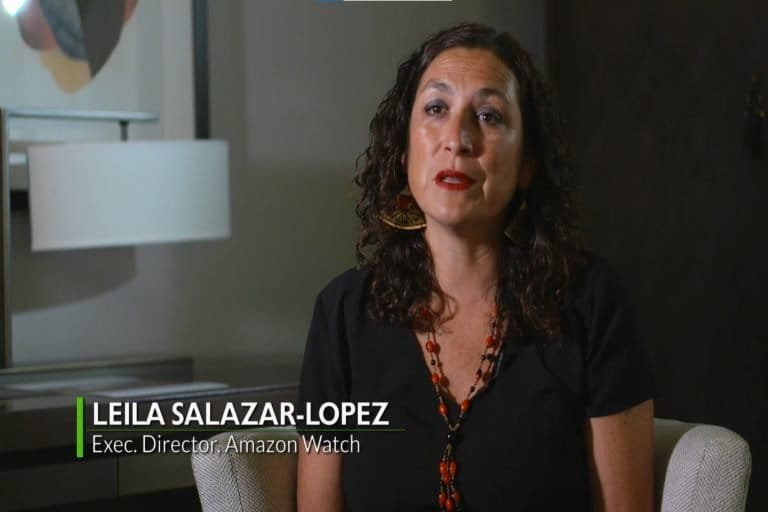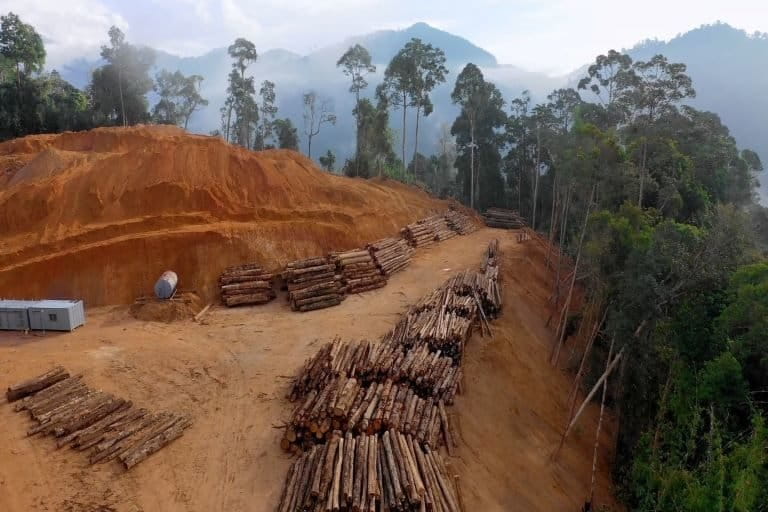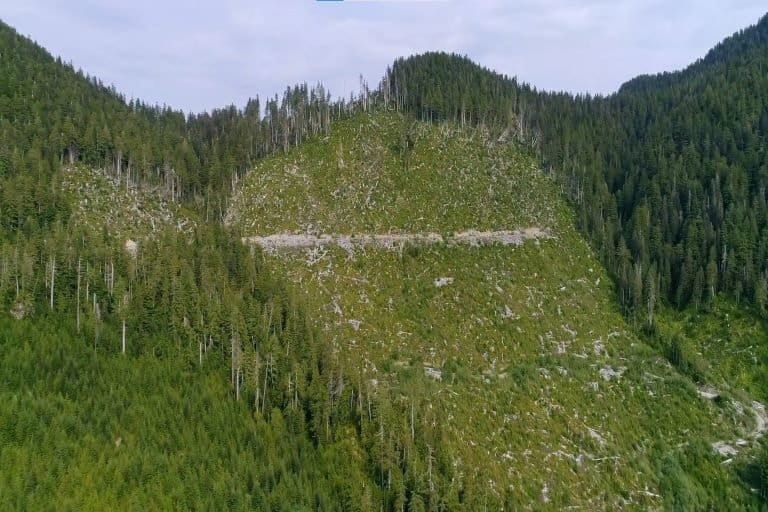
- A new documentary called “The Last Stand,” released on Earth Day 2022, goes inside the protests against the logging of the Fairy Creek old-growth forests in British Columbia, Canada.
- Leila Salazar-López, executive director of Amazon Watch, an NGO dedicated to fighting deforestation and protecting the rights of Indigenous communities in the world’s biggest rainforest, spoke in the film about the larger implications of cutting down old-growth forests.
- In an interview with Mongabay, Salazar-López talks deforestation in the Amazon, the flaws of carbon offset policies, and the important role that Indigenous and local people play in conserving the last of Earth’s old-growth forests.
Even after more than 1,000 people were arrested last year, protesters in British Columbia, Canada, continue to fight against the logging of the Fairy Creek old-growth forests. Blocking roads and tying themselves to trees, these frontline defenders have made headlines by putting their bodies between bulldozers and some of the oldest forests in the country.
A new documentary called The Last Stand, available for viewing this Earth Day 2022, goes inside the protests as they clash with police, giving a voice to some of the most dedicated frontline defenders. It also dives into the history of forest conservation there and tries to reconcile those efforts with the global demand for wood.
“We wanted to tell these stories so people could understand that we know much more about conserving trees now,” Peter von Puttkamer, the film’s director, told Mongabay. “It’s not just a matter of cutting them down and then replacing them with single crop trees, like a tree farm. You have to think about where you’re logging and how you log, because we need the wood. Even the protesters said they’re not against logging; they’re just protecting the old-growth.”
Von Puttkamer received the film assignment from David Casselman, the founder and CEO of Ecoflix, the world’s first nonprofit environmental streaming service, where the film is now up for viewing. After having done many films about wildlife, he wanted to find a subject matter that also stressed the importance of forest conservation and its impact on climate change and biodiversity.
“When you destroy these ancient forests, you destroy the underlying lines of communication, the fungal network that connects all these trees that allows them to thrive and allows animals to thrive,” von Puttkamer said.
Leila Salazar-López, executive director of Amazon Watch, an NGO dedicated to fighting deforestation and protecting the rights of Indigenous communities in the world’s biggest rainforest, is an important guest in the film.

Logging in Fairy Creek in not an anomaly, she says, but rather one of countless examples of old-growth forests that are being cleared all over the world. In several scenes, she connects the issues in Fairy Creek with those of the Amazon, pointing out that similar conservation dilemmas are being worked out wherever forests are under threat.
In this interview with Mongabay’s Maxwell Radwin, Salazar-López talks about deforestation in the Amazon and beyond, the flaws of carbon offset policies, and the important role Indigenous and local peoples play in conserving the last of Earth’s old-growth forests.
Mongabay: The film is primarily about old-growth forests in British Columbia. But your voice is an important one because you zoom out for viewers, explaining that this is just one example of a problem happening everywhere. Most notably in the Amazon.
Leila Salazar-López: It’s very clear that our planet is in crisis, and our planet is on fire. Anybody who’s been paying attention over the last three years has seen the climate crisis come to our front doorstep. We’ve seen wildfires engulf the entire West Coast, North America, from California to Washington, the boreal forests, even parts of the Arctic. We’ve seen fires rage from the Arctic to the Amazon to Australia. And so it’s no exaggeration to say that our planet is on fire and that our forests are on fire. And they’re on fire for many different reasons. They’re on fire from climate change, from drought — many of them here in California. Our wildfires, which have caught the world’s attention over the last few years, have been caused primarily by the impacts of climate change and drought.
We have to take a step back and think: why is there drought? One of the reasons is because of a lack of rainfall and snowpack in the Rockies and elsewhere. And that’s directly related to the deforestation and the change of the weather system in the Amazon rainforest. The Amazon rainforest is the largest and most biodiverse tropical rainforest on our planet. It is very, very, very threatened. And it’s threatened by deforestation, threatened by logging both legal and illegal. It’s threatened by extraction, oil and mining, threatened by industrial development and land grabbing. It’s also threatened by the attacks on the defenders of Indigenous people and the peoples who have been protecting the forests for thousands of years.
But one of the impacts of deforestation is the change to our global weather system. And in particular, the flying rivers of the Amazon, which is a term coined by a climate scientist in Brazil, Antonio Bilbray. Most people don’t know that above the Amazon are these flying rivers, the rain clouds, the weather system that is created by the standing forest. But with all of the deforestation and destruction and impacts on the Amazon rainforest, this weather system, these flying rivers, are off course. And they have been impacted, not only across the Amazon, but as far north as California and Colorado. Because these flying rivers don’t only stay in the Amazon, they actually irrigate the entire continent of South America, as far south as Argentina, and they also fly up all the way to North America. And so when these flying rivers are off course, they directly impact our weather system, which is the reason I started off by talking about drought and impacts to our forests. The forests around the world are one of our security blankets and one of our solutions to fighting climate change.

Mongabay: In the film, there is a sense that the people who should be addressing these problems aren’t listening. Are solutions to saving the forests being reached fast enough?
Leila Salazar-López: Well, you know, I was one of thousands of people at the last climate conference in Glasgow, COP26. And I was actually happy to hear that, finally, after 26 years, global governments and the private sector were making announcements at the very beginning of COP 26. The nongovernment organizations, the private sector and also foundations and philanthropists were making beautiful announcements about commitments to protecting forests and working with Indigenous peoples. Unfortunately, these announcements should have been made more than a decade ago. But I was happy to hear at the very beginning that there was an announcement made for a commitment of $1.7 billion by governments, by corporations, by philanthropists, to commit to protecting forests, investing in the protection of the world’s forests, and recognizing that Indigenous peoples are protecting forests. It took a really long time to get there.
For years, at least the last five years, we’ve heard over and over again that Indigenous peoples are the best protectors of the forest. We’ve been hearing this for decades. But in the last five to six years, there have been numerous reports, World Resources [Institute] and U.N. reports showing data that the best protected forests are those that are protected and held by Indigenous and traditional peoples. Eighty percent of the world’s biodiversity is within Indigenous peoples’ lands. And finally, we get this announcement, and it’s welcomed.
Then, we see the final results of COP, and once again, we’re disappointed because the fossil fuel industry actually had a bigger delegation than Indigenous peoples, and they were able to influence the ultimate results of the climate conference. There’s mentions of Indigenous peoples and forests but there’s no mention of extraction, there’s still no mention of the problem of fossil fuels. And that’s disappointing. That’s discouraging, because we know that we’re at a tipping point. We know we’re at the final hour.
Indigenous peoples and communities on the frontline and activists are taking a stand. Yet our governments continue to delay action or do the minimal action of what is really necessary. We need to stop deforestation. We need a moratorium on further deforestation … We need a moratorium on further fossil fuel extraction. We need to be rolling back the extraction, not expanding. And the reality is fossil fuel expansion continues in North America back to the Amazon.
Mongabay: What do you think about current deforestation policies in the Amazon? Jair Bolsonaro’s government in Brazil has been especially criticized. It appears to be leveraging the Ukrainian crisis in Russia to pass a bill that would allow further mining, for example.
Leila Salazar López: The Amazon is at a tipping point of ecological collapse. That is the truth. That is unfiltered. That is what Indigenous peoples have been putting up as a warning for decades, and I would even say centuries. Indigenous peoples have been warning the world that we need to stop this destruction and desecration of Mother Earth, or else we’re actually impacting our future survival on this planet. And they’ve been warning us. Now science has caught up to those warnings.
One of the major threats is industrial agribusiness and extraction, including mining. Right now in Brazil, there is the largest Indigenous mobilization in history. Over 7,000 Indigenous warriors are in Brasília for the upcoming Terra Livre, which is a free land camp they mobilize in defense of the rights and defense of their lives, their bodies and territories. One of the major calls from the free land camp is to stop Bill 191, which threatens 160,000 square kilometers [62,000 square miles] of forests. It opens up Indigenous lands to mining, to mineral extraction, to deforestation, to land grabbing. Currently, there are 2,500 active mining applications from hundreds of companies overlapping on over 200 Indigenous territories. These are just a few stats that have to do with mining, the opening up of Indigenous lands, which are the best protected in the Amazon.

The Bolsonaro administration is fast-tracking the opening of Indigenous peoples’ lands. It has been doing that since the moment Bolsonaro came into office just three years ago. The moment he came into office, he went on a full-scale attack on the environment, on the Amazon, on Indigenous peoples, women, on social movements. And we’ve seen the results of that. We’ve seen the defunding of the environment ministry. We’ve seen the defunding of the Indigenous ministry. We’ve seen those ministries being taken over by agribusiness lobbyists. And we’ve seen the results: we’ve seen the Amazon fire, we’ve seen the increased deforestation, we’ve seen these mining permits, we’ve seen fossil fuel extraction permits across the Brazilian Amazon that never existed before. The Brazilian Amazon is at the tipping point, and so is the rest of the Amazon.
We’re calling for 80% of the Amazon to be protected by 2025. That is a very ambitious goal, considering the state of the Amazon and the delayed response by the government. But that’s actually what’s needed. Climate scientists used to say that the tipping point would be reached at about 40% to 50% deforestation and degradation. But now they’re saying it’s at between 20% and 25%. And the Amazon is already at 21% deforestation. So that is why we’re saying protect the rest … If we don’t protect the rest of the Amazon, what’s left? It doesn’t mean we have to start from scratch, because already 3% of the Amazon is in Indigenous people’s hands. Another 20% is in protected areas, so if we actually invest in protecting those areas, and we protect what’s left, we have a chance. We need the commitments. We need the commitments by governments, we need the commitments by corporations, we need the commitments by the private sector. We need the commitments between now and the end, the next few years. And we need to stop the destruction in order to protect what’s left.
Mongabay: The film discusses the importance of logging, an industry it admits isn’t possible to erase altogether. But there are other solutions that could help save forests, such as selective sustainable logging.
Leila Salazar-López: For as long as I’ve been a forest activist and Indigenous rights activist, there’s been this story about the economic versus environment. That’s really what we’re talking about, right? It’s either we protect forests or we protect jobs. There’s always been that argument … But it’s not either-or. I don’t think anybody who is on the frontlines wants to see other people lose their jobs. But we don’t want to continue an economic model that destroys our forests, our ancient forests. We don’t want to see our ancient forests, our old-growth forests, our primary rainforests, destroyed for profit. And so there’s already so much land that is being used for timber. We already see so much land that’s being used for logging. Just one idea is to not expand into primary forests. I think that is really the call.
We are not going to get off wood any time soon, right? We all use wood. But we should use what we have available but not expand into primary forest. And I would argue that even some of those areas that have been used for logging before can be reforested and maintained to help the climate and absorb carbon, because that’s really what we need to do. We need forests to absorb this carbon. And we also need to keep the carbon and the fossil fuels in the ground … The just transition to a clean-energy economy is something we need to do around the world. We may be talking about forests right now but we’re also talking about fossil fuels and a low carbon economy.
That’s why they are global calls for a just transition, for a Green New Deal. That’s why we’re calling on environmental and frontline communities and Indigenous peoples and politicians and policymakers. They’re coming together for initiatives and proposals like the Green New Deal and … calling for a transfer of investments. Where are we investing our funds, our public funds and public and private funds? We should be investing in industries and solutions that are committed to reducing emissions, and keeping fossil fuels in the ground and protecting the forest that we have left. We call for true solutions to reducing emissions instead of questionable offset schemes that sound nice but are not truly reducing emissions.

Mongabay: You talk about some of that in the documentary. Carbon offsets or net-zero commitments are not going to “get us there.” What we really need are market mechanisms without carbon credits, since they continue to allow polluters to pollute.
Leila Salazar-López: The reality is in front of us. We’re at a climate tipping point. I stand with the calls of Indigenous peoples who are saying, ‘Trust us to protect our forest, we’ve been protecting our forests for thousands of years.’ [A good idea would be] directly investing in Indigenous peoples’ solutions, in the life plans and proposals of Indigenous peoples who are protecting their forests and want to continue protecting their forests. What the carbon-based offsets and market mechanisms have proposed are essentially opportunities for governments and corporations to continue doing business as usual. And business as usual is a reason we have had 26 years of climate conferences, and we have surpassed the 1.5°C [2.7°F] threshold for averting climate catastrophe. There need to be incentives, of course, for those who have polluted the most — fossil fuel industries in particular, agricultural industries. There need to be incentives, of course, for them to reduce emissions. But why should they get credit for offsetting emissions and continue to pollute?
Mongabay: What do you foresee for the old-growth forests of Fairy Creek moving forward?
Leila Salazar-López: Just like many frontline resistance campaigns around the world, the hope is that these old-growth forests are permanently protected, that this is the last time people have to put their bodies on the line, to risk everything to protect ancient forests. These are not forests that are going to regrow in 100 years in a forest concession. Once they’re gone, they’re gone.
What we support from Fairy Creek to the Kayapó territory in the Amazon is protecting the primary forests, protecting the ancient forests, protecting the living forests, the last ones that we have left, right here in the Pacific Northwest. In the north, we have less than 10% of our ancient forests left. In the Amazon, there’s still 80% that we can protect. That’s what we want to see. We want to see the remaining forests protected. We cannot afford to lose any more forests. We want to see respect for Indigenous peoples. We want to see respect for communities. We want to see respect for nature’s rights so that we can all have a future. We want our children to be able to see these ancient forests. We want our children to be able to breathe clean air and drink clean water. On the path we’re going, if we continue this path of destruction and desecration of the most treasured ancient forests and rivers, there is no hope for humanity and for our planet.
Banner image: A shot from the film of the Amazon rainforest. (Photo courtesy of Ecoflix)
FEEDBACK: Use this form to send a message to the author of this post. If you want to post a public comment, you can do that at the bottom of the page.
Saving old-growth forests: Q&A with Amazon Watch’s Leila Salazar-López
Source: Trends News

0 Comments